- Print
- DarkLight
- PDF
New Folder
Using Cerebrata, the user can easily create a Folder in a File Share.
Following are the steps to create a Folder in File Share:
- Open the File Share, select + New Folder
- Provide the Name of the Folder in the popup opened
- Click Save to a Folder in File Share
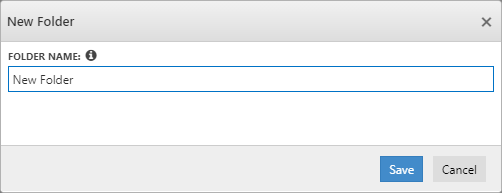
Upload Items
Cerebrata allows user to upload files and folders from the local storage.
Following are the steps to upload Files and Folders into File Share:
- Open the File Share, select Upload -> Upload Files/Folders.
- Select the Files/Folders to be uploaded and provide Chunk Size, Overwrite behaviour, Compress file extensions, Access tier
- Hit Upload to upload the Files/Folders
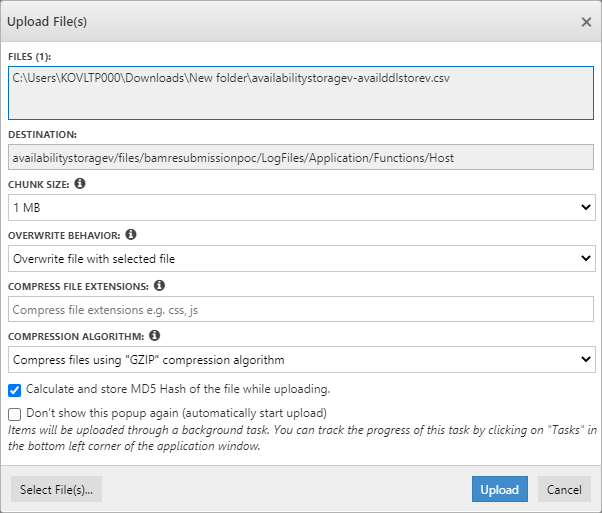
Download
Consider if the need is to backup the File shares into a local machine. Cerebrata allows users to download the files/folders into the required folders.
Following are the steps to download files/folders in Cerebrata:
- Open the File Share, select the files/folders to be downloaded and Click Download
- In the popup opened, select the folder when the files/folders to be downloaded, provide Overwrite behaviour and hit Download to download the files/folders
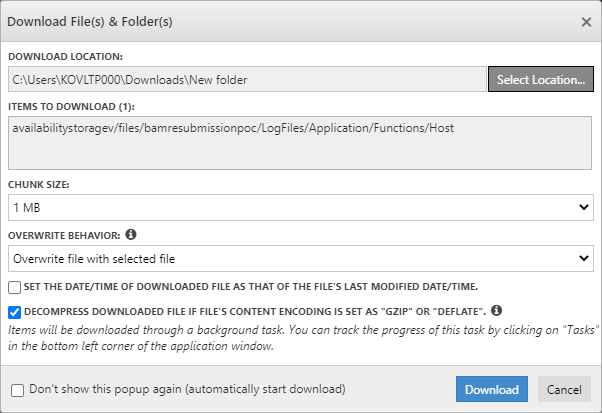
If a File Share is compressed with GZIP or DEFLATE compression algorithm, i.e. File share's content encoding is set as either "gzip" or "deflate", you can instruct Cerebrata to automatically decompress it after Download.
Delete File Share
User can delete either selected files/folders or all using Cerebrata.
Following are the steps to delete the files/folders from Storage File Share:
- Open the File Share, select the files/folders to be deleted and Click Delete
- It will open a popup and ask the user to enter the numbers in "VERIFICATION CODE" box into "CONFIRM CODE" box beside it.
- Once the Verification code is entered, Click Delete to delete the appropriate files/folders
Set Properties
Consider a scenario where you need to change the "cache-control" property of all files in a file share. By default, Azure Storage only allows you to change the property of an individual file. Cerebrata includes a neat convenience utility using which you can change properties like cache control, content-language, content-encoding, and content type of all files in a file share in a single click.
Cerebrata enables you to set NTFS attributes (e.g. archive, system. hidden etc.) on all files/folders in a file share. You choose from a list of pre-defined NTFS attributes, and those attributes will be set on all files/folders in a file share.
Cerebrata also enables you to set security descriptor permission in the SDDL format on all files/folders in a file share. You simply specify permission in SDDL format, and that permission will be set on all files/folders in a file share.
Following are the steps to define properties of File Share:
Set File Content Properties
- Open the File Share, select the folders to set properties, click Set Properties and select and Click Set File Content Properties
- It will open a popup and ask the user to enter Cache-control, Control Type, Content-Encoding and Content-Language.
- Once the properties are provided, click Submit to set the properties
Set File/Folder Attributes
- Open the File Share, select the folders to set attributes, click Set Properties and select Set File/Folder Attributes
- Select the attributes to be set and click Submit to set attributes
Set File/Folder Permissions
- Open the File Share, select the folders to set attributes, click Set Properties and select Set File/Folder Permissions
- Enter the required permissions to create on the files in Security Descriptor Definition Language and click Submit to set Permissions
Change Lease State
The Lease File operation creates and manages a lock on files in a File Share for write and deletes operations. Using Cerebrata, the user can change the lease state of a Storage file in a File Share. The lease duration can be fixed (between 15 to 60 seconds) or never expiring. Below are five modes Lease state available,
The Lease File operation can be called in one of five modes:
- Acquire, to request a new lease.
- Change, to change the ID of an existing lease.
- Release, to free the lease if it is no longer needed so that another client may immediately acquire a lease against the blob.
- Break, to end the lease but ensure that another client cannot acquire a new lease until the current lease period has expired.
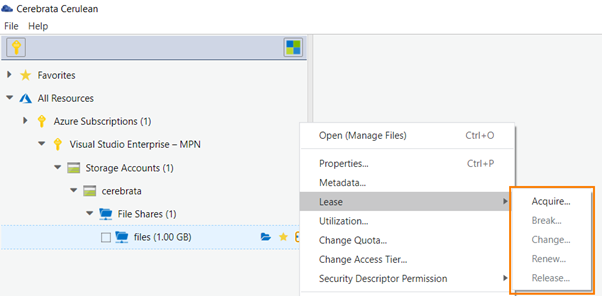
Settings
The user can enhance the management part of Storage Files in Azure Storage Account with Cerebrata's settings. To leverage these settings,
General Settings
Navigate to Files > Settings > Application Settings > Storage Settings> File Service
User can define the maximum number of shares to fetch from a storage account in a single request. The value provided must be greater than zero and less than or equal to 1000.

User can define the maximum number of files to fetch from a storage account in a single request. The value provided must be greater than zero and less than or equal to 1000.
User can include soft deleted file share while listing file shares and fetch additional properties of files/folders automatically after listing the files.
Set Tab Behaviour for opening the files and File Double Click Behaviour to view the files in different panel views.
Upload Settings
User can split the files into chunks and size of these chunks can be specified under Chunk Size tab. These chunks will be uploaded in parallel for faster upload.
Set Overwrite Behaviour to specify how application should behave if a file with same name as that of the uploaded file exists.

User can set compressed file extensions and compression algorithms for the files.
Calculate and store MD5 hash of the file while uploading and automatically start uploading
Download and Copy Settings
Set the date/time of downloaded file as that of the file's last modified date/time by enabling the check box.
User can decompress downloaded file if file's content encoding is set as "GZIP" or "DEFLATE".
Also, user can automate the download process by enabling the Automatically Start Download option.
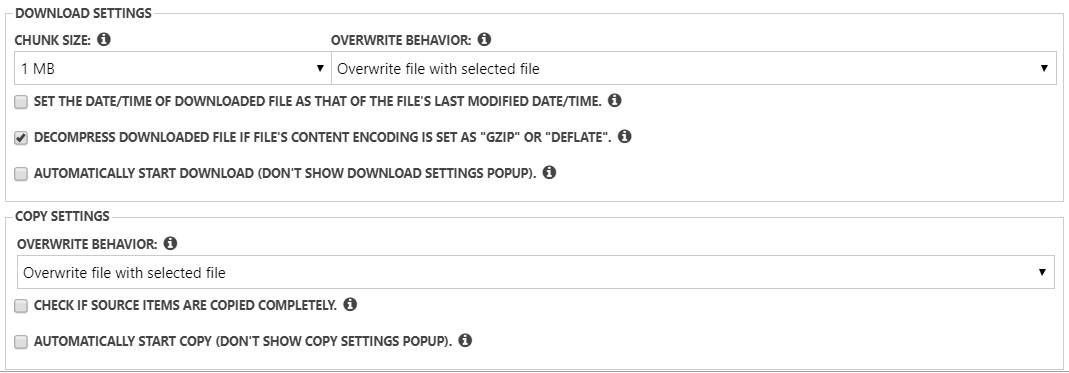
Set Overwrite Behaviour to specify how application should behave if a file with same name as that of the copied file exists.
Enable Check If Source Items are Copied Completely option to fetch target file's properties and check its copy status to ensure source items are copied completely.
Also, user can automate the copy process by enabling the Automatically Start Copy option.
